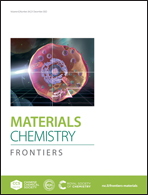Colloidal synthesis of size-confined CsAgCl2 nanocrystals: implications for electroluminescence applications†
Abstract
Because of their non-toxic properties and similar ionic radius to that of Pb2+, silver ion (Ag+)-containing perovskite derivatives have become an important class of Pb-free alternatives that are competitive for a variety of optoelectronic applications. Although great success has been achieved in producing Ag+-containing nanocrystals (NCs), such as Cs2AgInCl6 and Cs2AgBiCl6, colloidal synthesis of pure Ag-based emitters has remained challenging. Herein, we have devised a facile europium chloride (EuCl3)-based route to CsAgCl2 NCs with a tunable particle size and desirable warm white-light emission. To enhance the optical properties of CsAgCl2, we further demonstrate a trace doping strategy with Sb3+, which improves the quantum efficiency of the resulting NCs from 16% to 39%. Moreover, the addition of Sb3+ was found to significantly reduce the particle size of the CsAgCl2 NCs from a few hundred nanometers to several nanometers as a result of the reduced surface energy, paving the way for the formation of emissive layers with a well-controlled thickness and improved uniformity. Prototype electroluminescence devices fabricated using these nano-emitters exhibit favorable warm white-light (or yellow) emission, which opens up new avenues to develop single-component warm white light-emitting diodes.

- This article is part of the themed collection: FOCUS: Light-emitting diodes technology


 Please wait while we load your content...
Please wait while we load your content...